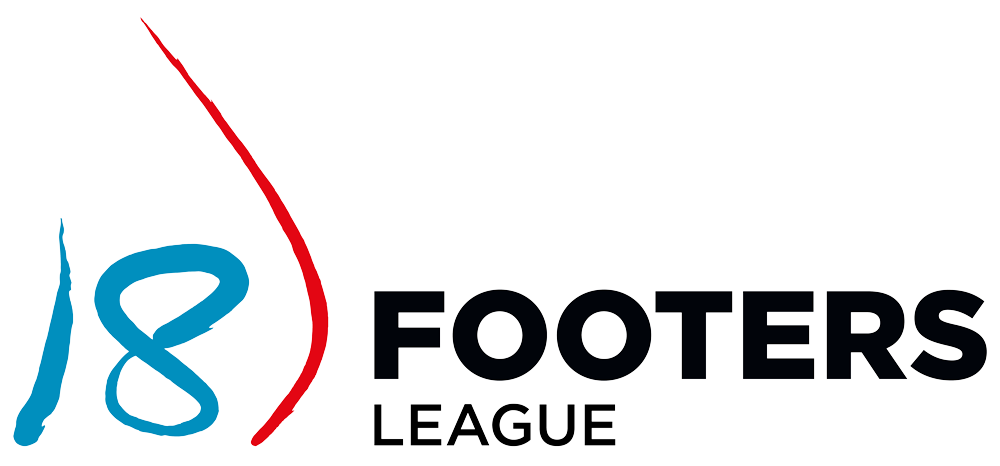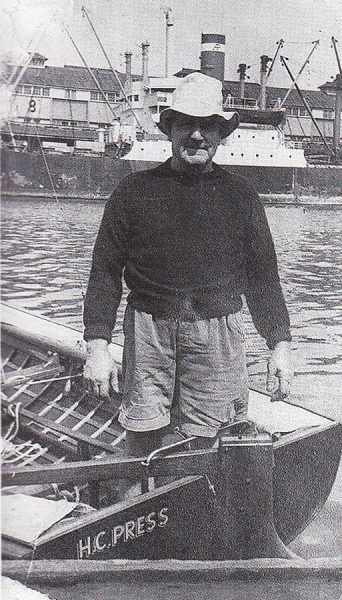One of the most famous names in Australian 18 footer history is H.C.Press, which must represent a world and Australian record, for continuous sailing of 16 boats bearing the same name and ‘two red horizontal bars’ logo , for a period of 45 years on Sydney Harbour.
The story of the man, Henry Christian Press, after whom the boats are named, and the generations of the Press family which has played such a significant part in the 18 footers’ history, is just as incredible as the record.
Henry Christian Press arrived in Australia as a cabin boy on a ship from Denmark in 1874 and found his way to the Palmer gold fields in 1875 where he was successful in finding gold said to be worth 350 pounds.
He returned to Sydney in 1876 and soon purchased his first boatshed, containing 13 rowing skiffs, on the eastern side of Woolloomooloo Bay, Sydney Harbour. He rented out the rowing skiffs as well as 22-24 sailing skiffs and hired a boat builder who taught him to build boats himself.
Henry married Annie in 1884 and had six children, including three boys Carl, George (Ned), and Syd.
The Government had plans to redevelop the area and the site of Press’ boatshed was going to be resumed so he submitted an application requesting a site on the western side of the bay. He then relocated the business onto a 30ftx60ft pontoon and it was towed over to the Domain side.
He operated his floating boatshed business for many years then opened his third boatshed business on the Cooks River, Tempe. A fourth was then established on the east side of the railway line near the Como train bridge.
A fifth boatshed, alongside the weir in the Audley National Park, was purchased. The ever-alert Press noticed an increase in the number of people coming to the park so he extended the boatshed to accommodate more rowing skiffs.
The additional skiffs were built at Audley and also at the Domain boatshed. The Domain skiffs were towed from there, by sea, to the Port Hacking River.
Another boatshed was built on the salt water side at Audley, but this was used only to store 54 rowing skiffs. There were 300 rowing skiffs between the two Audley sheds.
Henry Christian Press died at Audley on 25th July, 1925.
Henry Press encouraged his son George (also known as Ned) to take up sailing seriously, and with family assistance George built two 16 footers before deciding that he wanted to compete against the best open boat racing, and built the first H.C.Press 18 footer, which began its racing career in 1913.
George built a total of 12 H.C.Press 18 footers between 1913 and 1955, ten of which won championship races. He chose the ‘two red horizontal bars’ (his father’s racing colours) logo, which remained the colours on each of the H.C.Press 18 footers and sailed his H.C.Press boats with family members in the crew.
George’s follow-up H.C.Press II, in 1921, was the most successful boat racing in Australian waters during the 1920s and was the most successful of all his creations. According to Sydney Flying Squadron (SFS) records, “as owner, his boats won 27 club, Northern Rivers, Port Macquarie, State and Australian championships. As an owner-builder, he also won 15 cups and various other trophies.”
The Mark Foy Challenge Cup
During the 1922-23 season George Press coaxed Chris Webb out of his self-imposed exile, at the time, to sail a few races in H.C.Press II. Webb then returned full time in 1923-24 and won the 1923-24 and 1924-25 Mark Foy Challenge Cup in H.C.Press II.
When Webb took the H.C.Press II to victory again in 1926-27 it marked Webb’s fourth victory in the Mark Foy Challenge Cup (Webb had previously won with Australian III in 1913-14) and Mark Foy insisted that the trophy be presented to the boat’s owner – George Press.
Foy’s original intention was that it had to be won five times before it was won outright but he realised that it would be too difficult for any one boat to achieve during its competitive lifetime.
Turbulent times
Increased costs and the difficulty of boat owners to maintain large crew numbers in the early 1930s saw the introduction of the 7ft beam-type boat with a crew of seven, compared to the 12-13 of the ‘big boats’.
George Press believed that the smaller 7ft beam-type boat would be faster, but when the SFS refused to register these boats, George took his new (1933) H.C.Press IV boat, along with other owners who also wanted to race the new style boat, to the newly-formed NSW 18-Footers’ Sailing League.
George Press took the new, H.C.Press IV, boat to Brisbane for the 1933-34 Australian Championship and won the first race but finished as runner-up to Aberdare in the overall series. When the League held its first championship in March 1935, H.C.Press IV became the League’s first champion when she defeated The Mistake and Scot.
When the SFS finally removed its rules, George Press returned to the club in 1939. He brought the H.C.Press II out of retirement for racing at the SFS while still racing H.C.Press IV with the League.
Innovation
In 1941, George Press launched a new boat, H.C.Press VI, but his big break-through came in 1944 when he launched H.C.Press VII, the first of the modern 6ft beamers. Once again, according to Press, cost was a factor in the move to this new style boat, which he claimed he could build for half the price of a larger 18 footer.
The new style boat met the usual criticism from opponents to the smaller sails, as they had done back in the 1930s, when the first evolution came with the 7ft beamers.
Despite only moderately good performances over the first few seasons, her crew gradually came to grips with the boat and she won several SFS championships by 1947.
Queensland became interested and by the start of the 1947-48 season several new boats were launched in Sydney, giving the SFS fourteen 6ft beam boats in a nineteen-boat fleet.
George built twelve H.C.Press 18s and was skipper for most of the first ten (Chris Webb skippered in much of H.C.Press II & III). His nephew, Harry, became skipper in the mid-1950s and skippered the final six boats bearing the H.C.Press name.
During the period while George was skipper, there were usually other Press family members in the crew.
Harry Press sailed H.C.Press boats at the SFS and won the NSW Championship in H.C.Press IX in 1962-63 before his son, Murray, took over and won club pointscores and club championships. It got to H.C.Press XVI before Harry, Murray and Nick all moved into various sponsored 18s.
Despite the rising costs of campaigning 18s in the 1960s, Harry Press refused offers of sponsorship assistance “rather than leave behind the famous name of H.C.Press”
The new Australian 18 footer Championship trophy
Unfortunately, the original Mark Foy Challenge Cup, which was gifted to George Press in the late 1920s, was lost in a fire at the family home on Middle Harbour in 1968.
Many years later historian, John Steamer Stanley was talking with Keith Press about the loss of the trophy when Keith showed him the remains and said “you may as well take it”.
Steamer immediately contacted John (Woody) Winning, who decided to make a new trophy, which would become the Australian Championship trophy, and made sure that every winner’s name was engraved.
All metal components of the new trophy are 925 sterling silver. The three side plates and base plate are made from silver, refined from the original Mark Foy Challenge Cup. The base, holding the laurel supports for the boat, was the only component to survive the original. The sterling silver badges on the back, containing photos, are replications of the original badges on the galloping ghost trophy.
The Press name continues in skiffs
While no ‘Press family’ member presently races in the Sydney 18 footer fleet, the Press name is very strongly represented via the 12ft skiffs, where Nick Press boasts an incredible record of success and where his father, Murray, still races with the ‘two red horizontal bars’ logo of H.C.Press on the main.
While Nick is a ‘living legend’ in the 12s with nine Interdominion Championship victories to his credit, he also had seven seasons skippering in the 18 footers.
Smeg was his main skiff, and Nick recalls, “I was lucky enough to campaign it with and learn from two 18 footer skiff legends, Daniel Phillips and Dave Ewings, and we managed to take out some season point scores, a few championship heat wins. We also had a 2nd place in the Australian Championship and 5th In the JJ Giltinan, which were our best results.”
“I loved my time racing the 18-footers, not only being able to enjoy the best skiff racing in the world but knowing I was continuing a tradition that is such an important part of my family made it even more special for me. Although there is no Press name currently racing in the 18-footers, the name is still strong in the 12ft skiffs and will no doubt appear in the 18s again soon.”
According to Nick, “The 12s are an innovation class with boat handling a real challenge, making them very rewarding and enjoyable to race. The 12s and 18s also have strong links with many previous 12s Interdominion champions going on to successful 18 footers careers, showcasing their 12ft skiff boat handling.”
Nick started his career in the 12ft skiffs as a 16-year-old crew for his father, Murray, then later took on the challenge of skippering.
Since winning his first Interdominion 12ft skiff Championship, with Brad Yabsley, in 2005, Nick has amassed an incredible record of nine Interdominion Championship victories between 2005 and 2020. Three with Brad Yabsley, three with Andrew Stevenson and three with his present team mate Andrew Hay.
The Australian 18 footers class has a wonderful reputation for family involvement over its 130-year history but none come close to the five generations and 110-year (minimum) of the Press family.
Credits: Nick Press and Murray Press, Robin Elliott’s ‘Galloping Ghosts’ and John Steamer Stanley
Frank Quealey
Australian 18 Footers League Ltd.

